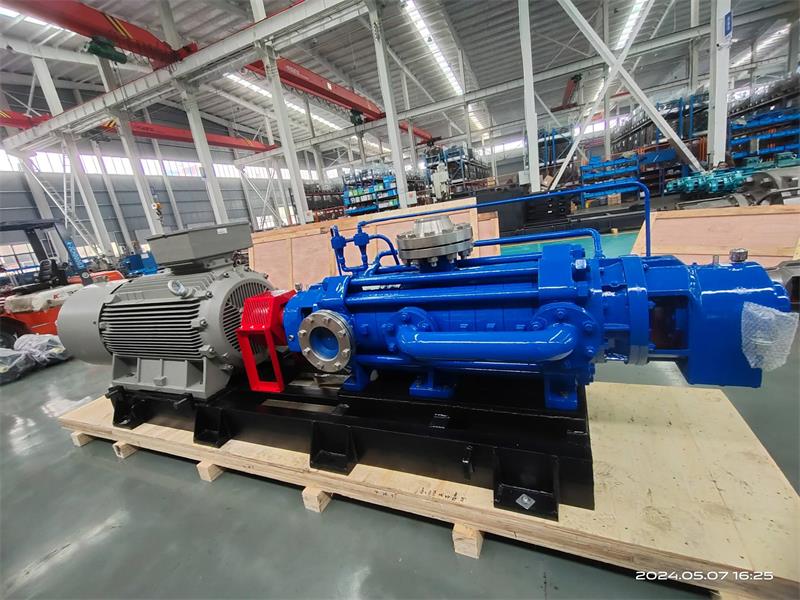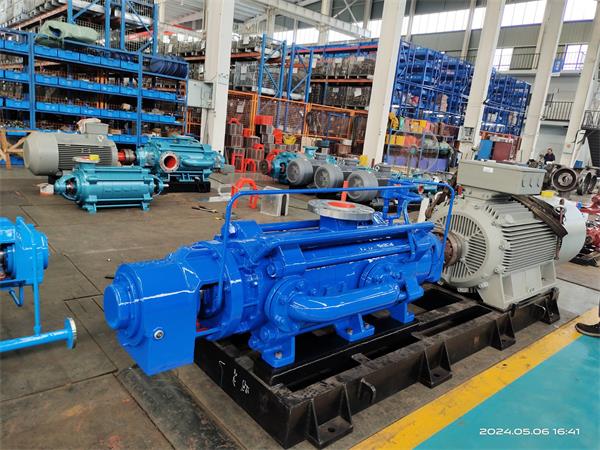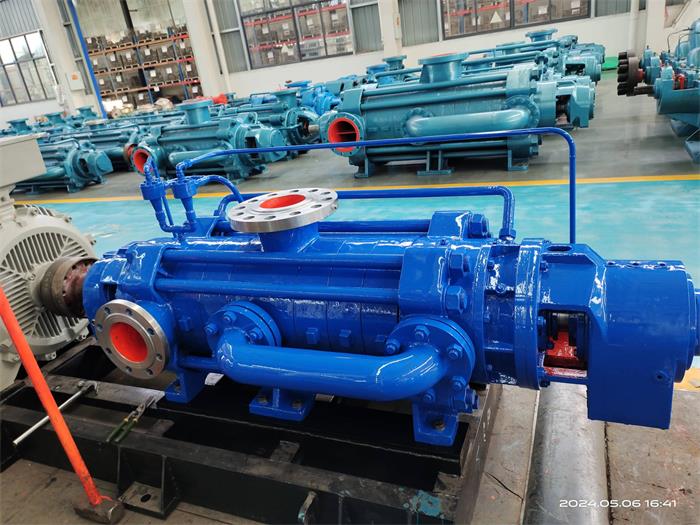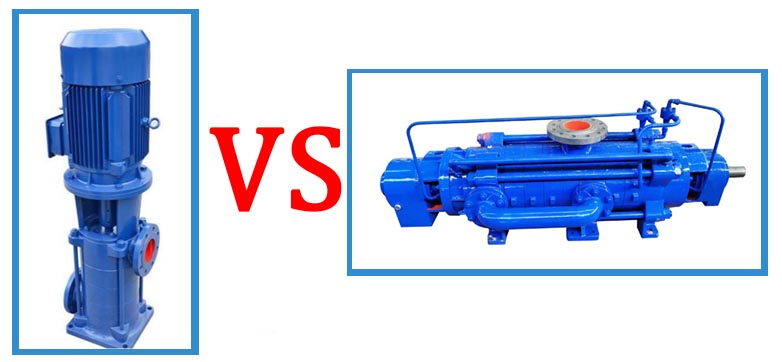Learn - May. 05, 2025



The boiler feed pumps are designed to deliver high pressure feedwater to boilers and handle intense inlet pressures while creating a big pressure boost, most of the boiler feed pumps are multistage type of centrifugal pumps(a few are plunger pumps), which pulling water from condensate systems and made from materials including cast steel, stainless steel, forged materials or even Titanium alloy. Furthermore, the multistage pump size and power must match the boiler's steam production, so engineers are supposed to carefully calculate the right flow rate, pressure, and temperature during design process.
Nowadays, high pressure centrifugal pumps are the ideal choice for boiler feed water pumps, due to improvements in power tech. and as fossil fuel plants keep getting bigger, these pumps have leveled up too—better materials(mainly casted stainless steels or forged stainless steels), smarter drive systems, and way more power handling.
Boilers are the quite essential equipment whether in factories or at homes, mainly because they are used for production of steam. They’re made up of different parts to generate steam or heat, using pipes for conveying water and steam around. Soot blowers keep things clean by blasting away fly ash with air or steam, and economizers reuse waste heat to warm up the feed water before it goes in. Burners are what start the fire—using fuels like gas, coal, oil, or even animal waste—and extras like insulation and heat-resistant materials help everything run more efficiently.
In order to make steam, you need a constant flow of water, which comes from boiler feed pumps. These feed water pumps are the key equipment for supplying high-pressure water from the deaerator into the boiler, so in fact, the whole system wouldn't function without them.
Even though boiler feed water pumps can vary in type and configuration, most of them share these same basic parts:
Casing and Impeller: The curved pump casing wraps around the impeller and helps guide the liquid as it moves through the pump. Meanwhile, the spinning impeller works to bump up both the fluid’s pressure and how fast it flows. You’ll usually find both of these parts made from tough stuff like cast iron or steel.
Electric Motor: This electric motor is what keeps the pump impeller turning at just the right speed for smooth operation. The motor’s horsepower? Well, that depends on how big the pump is and how much pressure it’s going to push out.
Bearing housing and Shaft Sealing: The bearings are there to support the shaft (the one the impeller’s stuck to) and let it spin nice and free. The shaft sealing, on the other hand, make sure water doesn’t go leaking out along the shaft. Bearings need their regular dose of lubrication, and seals—especially when dealing with hot feed water—might need swapping out every now and then.
Base plate: A sturdy pump base is what keeps everything mounted in place and lined up the way it should be. These bases are often cast iron or steel, and they're built tough to soak up any vibrations from the pump.
Couplings: This part hooks up the pump shaft to the motor shaft so the spinning power gets where it needs to go. It also helps smooth out any tiny misalignments between the two.
Flush system: The boiler feed water pumps(BFWP) may require external flush system(typically P21 and P23) to reduce the temperature of mechanical seals if the temperature of the pumping water is higher than 120 centigrade.
You might also find extra bits like pressure gauges, valves, and controls either hooked up to the feed water pump or bundled into pre-assembled pumping systems. Bottom line? Knowing these core pump parts helps operators keep performance in check, makes repairs less of a headache, and lets them chat more clearly with maintenance teams when something needs fixing.
These high-pressure boiler feed water pumps come in various sizes—some pack enough power to work in the range of a few kilowatt. Most are driven by electric motors through direct couplings, though in big industrial systems, high-capacity condensate pumps sometimes double as feed water pumps.
One key rule: The boiler feed pump’s output pressure has to be higher than the boiler’s steam pressure—otherwise, it can’t push water effectively.
High pressure Multistage Centrifugal pumps are the good choice for this job in a boiler system. Another common setup uses a continuous-operation pump with a minimum flow bypass. This little safety feature starts working during low-demand times, sending extra water back to the deaerator or feed tank to avoid pressure peak.
One of the biggest headaches with boiler feed pumps is how mechanical seals wear out from electrical erosion. Here's why it happens: since boiler water doesn't conduct electricity well, the rubbing action between seal rings builds up static charge with nowhere to go. This causes incredible quick wearing - we're talking chunks the size of your finger breaking off the rings! Sometimes, this severe problem happens even in less than one month of operation, leading to sudden, messy leaks.
However, the good news, mechanical seals with external flush water solve this issue nicely, making the seals and the BFP pumps last way longer.
However, here’s the good news - maintaining feed water pumps doesn't usually empty your wallet. The basic rules are quite simple to follow: keep bearings lubricated by oil, keep the mechanical seal flush water on, and keep an eye on those float level controls. Just pay attention - if your system's got corrosion issues, you might end up with leaking pipes.
What the boilers require is the balance - they need a steady, reliable water supply to work in a proper way. If the flow drops too low, you have the risk of running dry, which is terrible for the system. But if there's too much flow than designed value, you'll get carryover, which is also bad to the system. That's why nearly every smart system includes spare feed water pumps for boiler - it's like having a spare tire for your boiler system.
Boiler Feed pumps have one essential job: working as the booster water pump to create high enough pressure to push water into boilers against their operating pressure. For smaller auxiliary boiler systems, you'll often find compact size piston pumps or plunger pumps handling this job.
Most modern designed boilers are using electric motor driven multistage centrifugal pumps (also known as BB4 pumps) that run at fixed or steady speeds. Engineers are supposed to figure out how many pump stages are required based on the system's pressure design and how much water it has to move.
Regarding the big high-pressure water tube boilers, the design is quite different - they typically use special steam turbine driven pumps. These boiler feed pump units including a horizontal two-stage centrifugal pump and a steam turbine together in one compact package, saving space in the same time keeping the boiler system working efficiently.
Most boiler feed systems are adopting multistage centrifugal pumps to generate the high pressure by several tandem impellers back-to-back to build up pressure, and there are two main types: Vertical multistage inline pumps and then there's the horizontal multistage centrifugal pump.
Here's how these pumps work: they use an impeller to really get that water moving fast, then push it out at high speeds into the volute casing. The magic happens when all that fast-moving water (that's the kinetic energy) gets slowed down by the casing and turns into pressure energy instead.
Now, picking the right boiler feed water pump isn't just simple and easy- you have to consider a few key things: how much water it needs to move (that's the capacity), what pressure it's going to push out, what kind of power source you're working with, and the specific conditions where it'll be running. That's why it's always smart to have consulting engineers take a look - they'll give you recommendations that are tailored exactly to your system's needs.

Feature | Vertical | Horizontal |
Construction | Stainless steel stampings | Cast iron, stainless steel,forged materials,even titanium |
Required Space | Tall but narrow footprint | Longer horizontal space |
Performance | High pressure, but normal temperature resistance | Higher pressure and higher temperature resistance |
Maintenance | More complex procedures | Easier access for service |
Cost | Relatively cheap | Higher in cost than vertical type |
These adjust water flow continuously to match steam production perfectly. Yes, they're costly - needing qualified control valves, bigger diameter pipes, and powerful motors. But you would have:
● Steady water levels
● Less heat stress on equipment
● Longer lifespan of pump parts
These work like a light switch - either fully on or off, controlled by a simple float switch. While cheaper to install and easier to maintain, they come with trade-offs as follow:
● Cold water suddenly touching the hot surfaces then causes stress cracks
● Constant starting/stopping wears parts faster than usual
● Water levels are not stable
We may consider it like cruise control vs pumping the gas pedal - one gives a smooth ride, the other gets you there but wears the parts quicker.
When calculating how powerful your high pressure multistage pump needs to be, don't forget to those pressure differences into considerations:
→ System Pressure: The minimum your steam network requires
→ Economizer Resistance: How much pressure the economizer consumes
→ Check Valve Loss: Pressure drop at the one-way valve
→ Superheater Loss: Pressure used to push water through the superheater
→ Control Valve Drop: Pressure lost at the adjusting valve (skip this for simple on/off systems)
→ Height Difference: The required pressure to push water from pump to steam drum
→ Stop Valve Loss: The required pressure to get through shut-off valves
Pro Tip: We may consider it as water flowing through a series of narrow pipes - each section takes a little pressure to push through.
Total Discharge Pressure = Σ (All pressure losses)
Conversion:
PSIG to Head (ft) = Pressure × 2.31
Boiling Water Correction: Head ÷ 0.96 (for 227 °F/108 °C water density)
Startup Conditions:
● Cold starts lead pumps to severe thermal shock
● Rapid component heating brings stress gradients
● Frequent cycling accelerates fatigue failure
Design Challenges:
● Thin-walled vs thick-walled component heating rates
● Rotor/stator clearance maintenance during thermal transients
● Material selection for erosion/corrosion resistance (chrome steels and stainless steels are recommended)
Off-Design Operation:
● Low-flow conditions create thermal stratification
● Differential expansion risks seizure
● Requires extended cooldown periods for recovery
Primary Selection Criteria:
● Feed water pump pressure: Must be higher than boiler operating pressure
● NPSH Requirements: Must be at least 0.5 m lower than Net Positive Suction Head Available (NPSHa) to prevent cavitation
Cavitation Risks:
● Occurs if the suction pressure decreases below liquid vapor pressure
● Results in vapor bubble formation and collapse
● Causes damaging shockwaves leading to:
a. Impeller erosion
b. Vibration of pump
c.Potential pump failure
Configuration Options:
● Orientation: Evaluate space limits for vertical and horizontal installation
● Performance: Match head and flow rate to system requirements
● Control Method: Choose between on/off or modulating operation
If you want your boiler feed water pumps to keep working along reliably for years on end, your maintenance team needs to stick to the manufacturer's maintenance plan - you know, follow their recommended procedures and schedules to the letter. Here's the usual maintenance routine that works best:
● Keep those bearings and seals properly lubed up (exactly how the manufacturer says to do it)
● On time check the pumps for any signs of rust or wear and tear
● Make sure the insulation is holding up, especially for those hot water jobs
● Double-check that the pump and motor is properly aligned so you're not putting extra strain on the bearings
● Test out those suction and discharge pressure heads to make sure they're performing right
● Keep an eye on all the important numbers - flow rates, vibration patterns, and how much juice the pump's using
● Replace any worn-down parts like seals, bearings, or couplings when it is necessary
And here's a pro tip: your team should definitely keep a detailed log of every maintenance check and part replacement. When something starts acting up unexpectedly, nine times out of ten it's maintenance-related. Having those good records makes troubleshooting way easier when problems occur.Sticking to these standard maintenance practices for your boiler feed water pump is the best way to keep this crucial equipment running like a champ.
The fact is over a boiler system's lifetime, that feed water pump is putting in serious overtime, pushing hot water at high pressures for thousands of hours. That kind of rough treatment is bound to wear things down eventually. But if you stay on top of maintenance, you can really stretch out that pump's lifespan and keep it performing at its best. At last, this approach helps keep repair bills in check and prevents those annoying boiler system hiccups. When you really understand these pumps and how to manage the maintenance properly, you're setting up your whole boiler operation to run more efficiently.
Boiler feed water pumps serve a critical role—they deliver treated feed water to refill working fluid levels in boilers, keeping up with steady steam demand. These pumps are available in different types and setups to manage all sorts of boiler operating conditions. When sized correctly for the steam system, matching the needed capacity and pressure, feed water pumps help maintain smooth boiler performance. Following regular maintenance routines also keeps pump reliability strong over their full-service life. Facility teams who take the time to learn boiler feed water pump basics put themselves in a better position to make smart choices that boost system efficiency. Getting a solid handle on feed water pump fundamentals really pays off by strengthening boiler system performance in the long term.
If you still have doubts or questions regarding the boiler feed water pumps, please feel free to consult with our pump enginneers for evaluation of all operational parameters and pump model selection.
Contact us now: sales@zgpumpvalve.com or wa.me(Whatsapp: +8613738006567)
Visit our workshops by VR Tour
The Difference between a Self-Priming Pump and a Centrifugal Pump
Application Of Evaporation Circulation Pump In Chlor-alkali Industry
6 Steps To Find Out The Cause of Mechanical Seal Leakage of Chemical Centrifugal Pump
Reciprocating Triplex Plunger Pumps For Reverse Osmosis Seawater Desalination: A Comprehensive Guide